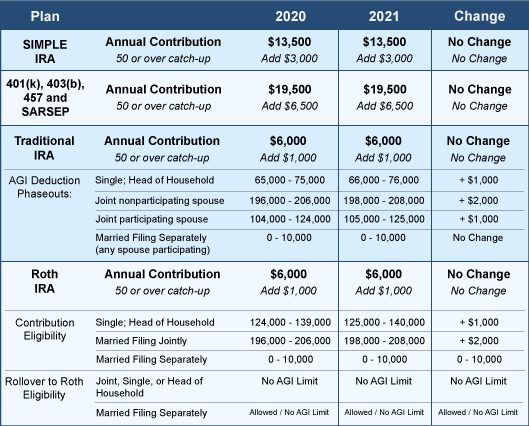There’s good news for your retirement accounts in 2022! The IRS recently announced that you can contribute more pre-tax money to several retirement plans in 2022. Take a look at the following contribution limits for several of the more popular retirement plans:

What You Can Do
- Look for your retirement savings plan from the table and note the annual savings limit of the plan. If you are 50 years or older, add the catch-up amount to your potential savings total.
- Make adjustments to your employer provided retirement savings plan as soon as possible in 2022 to adjust your contribution amount.
- Double check to ensure you are taking full advantage of any employee matching contributions into your account.
- Use this time to review and re-balance your investment choices as appropriate for your situation.
- Set up new accounts for a spouse and/or dependents. Enable them to take advantage of the higher limits, too.
- Consider IRAs. Many employees maintain employer-provided plans without realizing they could also establish a traditional or Roth IRA. Use this time to review your situation and see if these additional accounts might benefit you or someone else in your family.
- Review contributions to other tax-advantaged plans, including flexible spending accounts (FSAs) and health savings accounts (HSAs).
Now is a great time to make 2022 a year to remember for retirement savings!



 Suppose you’re switching jobs if you were furloughed because of the pandemic or you’re simply searching for greener pastures. If you have a 401(k) from your soon-to-be former employer, you must decide what to do with your retirement account when you leave. Here are your four options:
Suppose you’re switching jobs if you were furloughed because of the pandemic or you’re simply searching for greener pastures. If you have a 401(k) from your soon-to-be former employer, you must decide what to do with your retirement account when you leave. Here are your four options: Under the Coronavirus Aid, Relief, and Economic Security (CARES) Act, you may be able to take money out of a qualified plan, like a 401(k), or an IRA, with favorable tax consequences. But should you do it? You might view withdrawing money from a retirement account as a last resort.
Under the Coronavirus Aid, Relief, and Economic Security (CARES) Act, you may be able to take money out of a qualified plan, like a 401(k), or an IRA, with favorable tax consequences. But should you do it? You might view withdrawing money from a retirement account as a last resort.